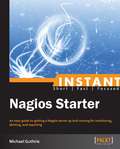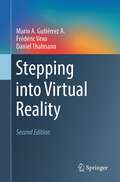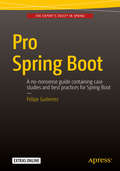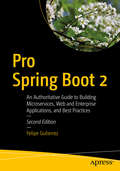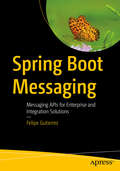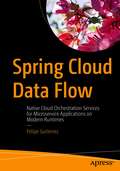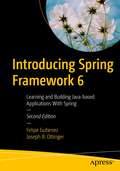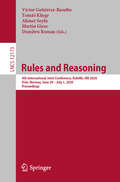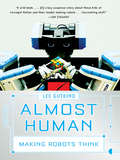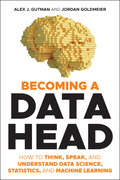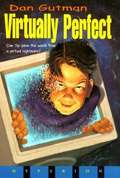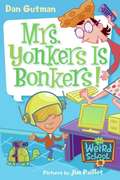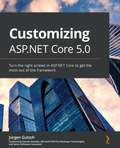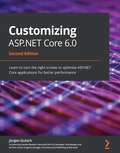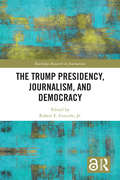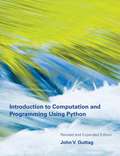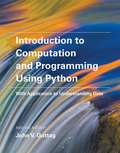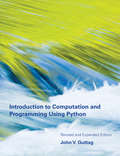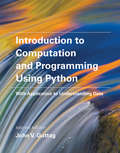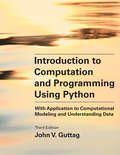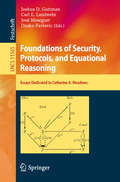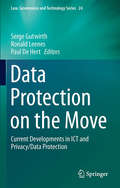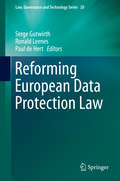- Table View
- List View
Instant Nagios Starter
by Michael GuthrieGet to grips with a new technology, understand what it is and what it can do for you, and then get to work with the most important features and tasks.A concise guide, written in an easy-to-follow format.Instant Nagios Starter is an outstanding resource for system engineers, administrators and developers, with a basic understanding of the Linux command line Readers should have access to a test system or virtual machine with Linux installed to follow the given examples.
Stepping into Virtual Reality
by Mario A. Gutiérrez A. Frédéric Vexo Daniel ThalmannVirtual reality techniques are increasingly becoming indispensable in many areas. This book looks at how to generate advanced virtual reality worlds. It covers principles, techniques, devices and mathematical foundations, beginning with basic definitions, and then moving on to the latest results from current research and exploring the social implications of these. Very practical in its approach, the book is fully illustrated in colour and contains numerous examples, exercises and case studies. This textbook will allow students and practitioners alike to gain a practical understanding of virtual reality concepts, devices and possible applications.
Pro Spring Boot
by Felipe GutierrezIncrease your Spring Framework-based enterprise Java and cloud application productivity while decreasing development time using the Spring Boot productivity suite of tools. This book is a no-nonsense guide with case studies of increasing complexity throughout the book. Pro Spring Boot is written by Felipe Gutierrez, a Spring expert consultant who works with Pivotal, the company behind the Spring Framework. Spring Boot makes it easy to create stand-alone, production-grade Spring-based applications that you can almost "just run". The goal is to allow you to get started with minimum fuss. Most Spring Boot applications need very little Spring configuration. Spring Boot provides a radically faster and widely accessible getting started experience for all Spring development and provides a range of non-functional features that are common to large classes of projects (e. g. embedded servers, security, metrics, health checks, externalized configuration); and with absolutely no code generation nor requirements for XML configuration. After you read and use this book, you'll be able to develop complex Spring applications and microservices with minimal fuss on things like configurations. This book will let you fully leverage the Spring Boot productivity suite of tools and show you how to apply them through the use of a few case studies as well. What you'll learn What is Spring Boot and how to write your first Spring Boot application How to configure Spring Boot How to use the Spring Boot Actuator How to do web development with Spring Boot How to build microservices with Spring Boot How to handle databases and messaging with Spring Boot How to test and deploy with Spring Boot How to extend Spring Boot and its available plug-ins Who this book is for This book is for experienced Spring and Java developers seeking increased productivity gains and decreased complexity and development time in their applications and software services writing.
Pro Spring Boot 2: An Authoritative Guide To Building Microservices, Web And Enterprise Applications, And Best Practices
by Felipe GutierrezQuickly and productively develop complex Spring applications and microservices out of the box, with minimal concern over things like configurations. This revised book will show you how to fully leverage the Spring Boot 2 technology and how to apply it to create enterprise ready applications that just work. It will also cover what's been added to the new Spring Boot 2 release, including Spring Framework 5 features like WebFlux, Security, Actuator and the new way to expose Metrics through Micrometer framework, and more.This book is your authoritative hands-on practical guide for increasing your enterprise Java and cloud application productivity while decreasing development time. It's a no nonsense guide with case studies of increasing complexity throughout the book. The author, a senior solutions architect and Principal Technical instructor with Pivotal, the company behind the Spring Framework, shares his experience, insights and first-hand knowledge about how Spring Boot technology works and best practices.Pro Spring Boot 2 is an essential book for your Spring learning and reference library.What You Will LearnConfigure and use Spring Boot Use non-functional requirements with Spring Boot ActuatorCarry out web development with Spring BootPersistence with JDBC, JPA and NoSQL DatabasesMessaging with JMS, RabbitMQ and WebSocketsTest and deploy with Spring BootA quick look at the Spring Cloud projectsMicroservices and deployment to the CloudExtend Spring Boot by creating your own Spring Boot Starter and @Enable featureWho This Book Is ForExperienced Spring and Java developers seeking increased productivity gains and decreased complexity and development time in their applications and software services.
Spring Boot Messaging
by Felipe GutierrezBuild messaging applications using the power of Spring Boot; use Spring application events over the Web; use WebSocket, SockJS, and STOMP messaging with Spring MVC; and use Spring JMS, Redis Pub/Sub and Spring AMQP for reliable messaging solutions. This book covers all the Spring Messaging APIs using Spring Boot. Written by a Pivotal engineer, Spring Boot Messaging is an authoritative guide to the many messaging APIs and how to use these for creating enterprise and integration solutions. You will learn and integrate these messaging APIs with more complex enterprise and cloud applications: for example, you will see how to use Spring Cloud Stream for creating message-driven and cloud native microservices. In addition, you'll discover the new Spring Integration DSL and use it with Spring Cloud Stream to build integration solutions using every enterprise integration pattern. Finally, you'll see Spring Reactor and Spring Cloud to take your application to the next level. After reading this book, you will come away with a case study application walk-through and will be able to use it as a template for building your own Spring messaging applications or messaging features within your enterprise or cloud application. What You'll Learn Use the main Spring messaging APIs with Spring Framework 5 Build messaging applications over the Web Use WebSocket, SockJS, and STOMP messaging Integrate Spring JMS and Spring AMQP into your applications Work with Spring Cloud Stream and microservices Who This Book Is For Enterprise Java developers who have at least some previous experience with the Spring Framework and/or the Spring platform.
Spring Cloud Data Flow: Native Cloud Orchestration Services for Microservice Applications on Modern Runtimes
by Felipe GutierrezWork with big data applications by using Spring Cloud Data Flow as a unified, distributed, and extensible system for data ingestion and integration, real-time analytics and data processing pipelines, batch processing, and data export. With this book you will develop a foundation for creating applications that use real-time data streaming by combining different technologies and use the full power of Spring Cloud Data Flow. The first part of Spring Cloud Data Flow introduces the concepts you will need in the rest of the book. It begins with an overview of the cloud, microservices, and big data, before moving on to the Spring projects essential to modern big data applications in Java: Spring Integration, Spring Batch, Spring Cloud Stream, and Spring Cloud Task. The second part of the book covers the internals of Spring Cloud Data Flow, giving you the insights and knowledge required to build the applications you need. You'll learn how to use Spring Data Flow's DSL and how to integrate with third-party cloud platform solutions, such as Kubernetes. Finally, the book covers Spring Cloud Data Flow applications to impart practical, useful skills for real-world applications of the technologies covered throughout the rest of the book. What You Will LearnSee the Spring Cloud Data Flow internals Create your own Binder using NATs as BrokerMater Spring Cloud Data Flow architecture, data processing, and DSLIntegrate Spring Cloud Data Flow with KubernetesUse Spring Cloud Data Flow local server, Docker Compose, and KubernetesDiscover the Spring Cloud Data Flow applications and how to use themWork with source, processor, sink, tasks, Spring Flo and its GUI, and analytics via the new Micrometer stack for realtime visibility with Prometheus and Grafana Who This Book Is ForThose with some experience with the Spring Framework, Microservices and Cloud Native Applications. Java experience is recommended.
Introducing Spring Framework 6: Learning and Building Java-based Applications With Spring
by Felipe Gutierrez Joseph B. OttingerSpring Framework 6 remains - by far - the leading de-facto "out of the box" practical Java meta application development framework for building complex enterprise, cloud-native applications as well as web applications and microservices. Introducing Spring Framework 6 is your hands-on tutorial guide for learning the Spring Framework 6 from top to bottom, and allows you to build an example application along the way from the ground-up.As you learn the Spring Framework over the course of this book, you’llincrementally build your first Spring application piece-by-piece as you learn each module, project or component of the Spring Framework and its extensions and ecosystem. As you learn the various fundamentals, you'll then apply them immediately to your Spring application. This Spring application, My Documents, enables you to learn by doing. After reading this book, you will have the essentials you should need to start using the Spring Framework and building your own Java-based applications or microservices with it.What you'll learn:Get started with Spring Framework 6 by VMWare Tanzu and the Spring communityBuild your first My Documents application using Spring Framework and its extensionsTest your Spring applicationAdd persistence to your application using Spring Data JPA and moreShow your Spring application on the Web with Spring MVC and relatedUse REST APIs to enhance your application and add messaging with Kafka and AMQPIntegrate your Spring application with external systems using Spring Integration toolkitWho is this book for:This book is for those aspiring software developers and programmers who are new to Spring. Some prior programming experience recommended, preferably in Java.
Rules and Reasoning: 4th International Joint Conference, RuleML+RR 2020, Oslo, Norway, June 29 – July 1, 2020, Proceedings (Lecture Notes in Computer Science #12173)
by Víctor Gutiérrez-Basulto Tomáš Kliegr Ahmet Soylu Martin Giese Dumitru RomanThis book constitutes the proceedings of the International Joint Conference on Rules and Reasoning, RuleML+RR 2020, held in Oslo, Norway, during June-July 2020*. This is the 4th conference of a new series, joining the efforts of two existing conference series, namely “RuleML” (International Web Rule Symposium) and “RR” (Web Reasoning and Rule Systems).The 7 full research papers presented together with 6 short technical communications papers were carefully reviewed and selected from 30 submissions.*The conference was held virtually due to the COVID-19 pandemic.
Almost Human: Making Robots Think
by Lee GutkindA remarkable, intense portrait of the robotic subculture and the challenging quest for robot autonomy. The high bay at the Robotics Institute at Carnegie Mellon University is alive and hyper night and day with the likes of Hyperion, which traversed the Antarctic, and Zoe, the world's first robot scientist, now back home. Robot Segways learn to play soccer, while other robots go on treasure hunts or are destined for hospitals and museums. Dozens of cavorting mechanical creatures, along with tangles of wire, tools, and computer innards are scattered haphazardly. All of these zipping and zooming gizmos are controlled by disheveled young men sitting on the floor, folding chairs, or tool cases, or huddled over laptops squinting into displays with manic intensity. Award-winning author Lee Gutkind immersed himself in this frenzied subculture, following these young roboticists and their bold conceptual machines from Pittsburgh to NASA and to the most barren and arid desert on earth. He makes intelligible their discoveries and stumbling points in this lively behind-the-scenes work.
Becoming a Data Head: How to Think, Speak, and Understand Data Science, Statistics, and Machine Learning
by Alex J. Gutman Jordan Goldmeier"Turn yourself into a Data Head. You'll become a more valuable employee and make your organization more successful." Thomas H. Davenport, Research Fellow, Author of Competing on Analytics, Big Data @ Work, and The AI Advantage You’ve heard the hype around data—now get the facts. In Becoming a Data Head: How to Think, Speak, and Understand Data Science, Statistics, and Machine Learning, award-winning data scientists Alex Gutman and Jordan Goldmeier pull back the curtain on data science and give you the language and tools necessary to talk and think critically about it. You’ll learn how to: Think statistically and understand the role variation plays in your life and decision making Speak intelligently and ask the right questions about the statistics and results you encounter in the workplace Understand what’s really going on with machine learning, text analytics, deep learning, and artificial intelligence Avoid common pitfalls when working with and interpreting data Becoming a Data Head is a complete guide for data science in the workplace: covering everything from the personalities you’ll work with to the math behind the algorithms. The authors have spent years in data trenches and sought to create a fun, approachable, and eminently readable book. Anyone can become a Data Head—an active participant in data science, statistics, and machine learning. Whether you’re a business professional, engineer, executive, or aspiring data scientist, this book is for you.
Virtually Perfect
by Dan GutmanYip Turner spends more time playing computer games than with other kids. For him, virtual reality usually beats reality! So when his dad, a movie special-effects designer, brings home new software for creating virtual actors, Yip is psyched. He and his sister create "Victor," a boy who is smart, handsome, and charming-perfect in everyway. But when Victor leaves cyberspace and invades their world, Yip realizes that there are bugs in the virtual-actor software. Now his family-and possibly the whole country!-may be in danger..
Mrs. Yonkers Is Bonkers! (My Weird School #18)
by Dan Gutman Jim PaillotSomething weird is going on!Mrs. Yonkers, the computer teacher, is the nerdiest teacher in the history of the world. She can type with her feet! She buys foam cheeseheads off eBay! She even puts a Webcam on a turtle! Is she trying to take over the planet?
Customizing ASP.NET Core 5.0: Turn the right screws in ASP.NET Core to get the most out of the framework
by Jurgen Gutsch Damien BowdenA guide to discovering the hidden behaviors of ASP.NET Core that can be customized to optimize your .NET 5 applicationsKey FeaturesCustomize the default behavior of ASP.NET Core to get the most out of the frameworkEnhance the app configuration, change the default dependency injection, and build your own tag helpersDiscover best practices for configuring ASP.NET Core, from user interface design to hosting it on platformsBook DescriptionASP.NET Core is the most powerful Microsoft web framework. Although it's full of rich features, sometimes the default configurations can be a bottleneck and need to be customized to suit the nature and scale of your app. If you're an intermediate-level .NET developer who wants to extend .NET Core to multiple use cases, it's important to customize these features so that the framework works for you effectively. Customizing ASP.NET Core 5.0 covers core features that can be customized for developing optimized apps. The customization techniques are also updated to work with the latest .NET 5 framework. You'll learn essential concepts relating to optimizing the framework such as configuration, dependency injection, routing, action filters, and more. As you progress, you'll be able to create custom solutions that meet the needs of your use case with ASP.NET Core. Later chapters will cover expert techniques and best practices for using the framework for your app development needs, from UI design to hosting. Finally, you'll focus on the new endpoint routing in ASP.NET Core to build custom endpoints and add third-party endpoints to your web apps for processing requests faster. By the end of this application development book, you'll have the skills you need to be able to customize ASP.NET Core to develop robust optimized apps.What you will learnExplore various application configurations and providers in ASP.NET Core 5Understand dependency injection in .NET and learn how to add third-party DI containersDiscover the concept of middleware and write your own middleware for ASP.NET Core appsCreate various API output formats in your API-driven projectsGet familiar with different hosting models for your ASP.NET Core appDevelop custom routing endpoints and add third-party endpointsConfigure WebHostBuilder effectively for your web applicationsWho this book is forThis .NET 5 book is for .NET developers who need to change the default behaviors of the framework to help improve the performance of their applications. Intermediate-level knowledge of ASP.NET Core and C# is required before getting started with the book.
Customizing ASP.NET Core 6.0: Learn to turn the right screws to optimize ASP.NET Core applications for better performance, 2nd Edition
by Jurgen Gutsch Damien BowdenExplore hidden behaviors and customization techniques to help you get the most out of ASP.NET Core for building web applicationsKey FeaturesSecond edition updated and enhanced to cover the latest .NET 6 features and changesLearn expert techniques to implement authentication and authorization for securing your web appsDiscover best practices for configuring ASP.NET Core, from user interface design to hosting it on platformsBook DescriptionASP.NET Core comes packed full of hidden features for building sophisticated web applications. You'd be missing out on a lot of its capabilities by not customizing it to work for your applications. With Customizing ASP.NET Core 6.0, you'll discover techniques to help you get the most out of the framework to deliver robust applications.In this updated second edition, you'll cover the latest features and changes in the .NET 6 LTS version. You'll find new insights and customization techniques for important topics such as authentication and authorization. The book will also show you how to work with caches and change the default behavior of ASP.NET Core apps. You'll learn essential concepts relating to optimizing the framework, such as configuration, dependency injection, routing, action filters, and more. As you progress, you'll be able to create custom solutions that meet the needs of your use case with ASP.NET Core. Later chapters will cover expert techniques and best practices for using the framework for your app development needs, from UI design to hosting. Finally, you'll focus on the new endpoint routing in ASP.NET Core to build custom endpoints and add third-party endpoints to your web apps for processing requests faster.By the end of this book, you'll be able to customize ASP.NET Core to develop robust optimized apps.What you will learnExplore various application configurations and providers in ASP.NET Core 6Enable and work with caches to improve the performance of your applicationUnderstand dependency injection in .NET and learn how to add third-party DI containersDiscover the concept of middleware and write your middleware for ASP.NET Core appsCreate various API output formats in your API-driven projectsGet familiar with different hosting models for your ASP.NET Core appWho this book is forThis .NET 6 book is for .NET developers who need to change the default behaviors of the framework to help improve the performance of their applications. Intermediate-level knowledge of ASP.NET Core and C# is required before getting started with the book.
The Trump Presidency, Journalism, and Democracy (Routledge Research in Journalism)
by Robert E. Gutsche Jr.This book examines the disruptive nature of Trump news – both the news his administration makes and the coverage of it – related to dominant paradigms and ideologies of U.S. journalism. By relying on conceptualizations of media memory and "othering" through news coverage that enhances socio-conservative positions on issues such as immigration, the book positions this moment in a time of contestation. Contributors ranging from scholars, professionals, and media critics operate in unison to analyze today’s interconnected challenges to traditional practices within media spheres posed by Trump news. The outcomes should resonate with citizens who rely on journalism for civic engagement and who are active in social change
Introduction to Computation and Programming Using Python
by John V. GuttagThis book introduces students with little or no prior programming experience to the art of computational problem solving using Python and various Python libraries, including PyLab. It provides students with skills that will enable them to make productive use of computational techniques, including some of the tools and techniques of "data science" for using computation to model and interpret data. The book is based on an MIT course (which became the most popular course offered through MIT's OpenCourseWare) and was developed for use not only in a conventional classroom but in a massive open online course (or MOOC) offered by the pioneering MIT-Harvard collaboration edX.Students are introduced to Python and the basics of programming in the context of such computational concepts and techniques as exhaustive enumeration, bisection search, and efficient approximation algorithms. The book does not require knowledge of mathematics beyond high school algebra, but does assume that readers are comfortable with rigorous thinking and not intimidated by mathematical concepts. Although it covers such traditional topics as computational complexity and simple algorithms, the book focuses on a wide range of topics not found in most introductory texts, including information visualization, simulations to model randomness, computational techniques to understand data, and statistical techniques that inform (and misinform) as well as two related but relatively advanced topics: optimization problems and dynamic programming. Introduction to Computation and Programming Using Python can serve as a stepping-stone to more advanced computer science courses, or as a basic grounding in computational problem solving for students in other disciplines.
Introduction to Computation and Programming Using Python: With Application to Understanding Data
by John V. GuttagThis book introduces students with little or no prior programming experience to the art of computational problem solving using Python and various Python libraries, including PyLab. It provides students with skills that will enable them to make productive use of computational techniques, including some of the tools and techniques of data science for using computation to model and interpret data. The book is based on an MIT course (which became the most popular course offered through MIT's OpenCourseWare) and was developed for use not only in a conventional classroom but in in a massive open online course (MOOC). This new edition has been updated for Python 3, reorganized to make it easier to use for courses that cover only a subset of the material, and offers additional material including five new chapters.Students are introduced to Python and the basics of programming in the context of such computational concepts and techniques as exhaustive enumeration, bisection search, and efficient approximation algorithms. Although it covers such traditional topics as computational complexity and simple algorithms, the book focuses on a wide range of topics not found in most introductory texts, including information visualization, simulations to model randomness, computational techniques to understand data, and statistical techniques that inform (and misinform) as well as two related but relatively advanced topics: optimization problems and dynamic programming. This edition offers expanded material on statistics and machine learning and new chapters on Frequentist and Bayesian statistics.
Introduction to Computation and Programming Using Python
by John V. GuttagThis book introduces students with little or no prior programming experience to the art of computational problem solving using Python and various Python libraries, including PyLab. It provides students with skills that will enable them to make productive use of computational techniques, including some of the tools and techniques of "data science" for using computation to model and interpret data. The book is based on an MIT course (which became the most popular course offered through MITs OpenCourseWare) and was developed for use not only in a conventional classroom but in in a massive open online course (or MOOC) offered by the pioneering MIT--Harvard collaboration edX. Students are introduced to Python and the basics of programming in the context of such computational concepts and techniques as exhaustive enumeration, bisection search, and efficient approximation algorithms. The book does not require knowledge of mathematics beyond high school algebra, but does assume that readers are comfortable with rigorous thinking and not intimidated by mathematical concepts. Although it covers such traditional topics as computational complexity and simple algorithms, the book focuses on a wide range of topics not found in most introductory texts, including information visualization, simulations to model randomness, computational techniques to understand data, and statistical techniques that inform (and misinform) as well as two related but relatively advanced topics: optimization problems and dynamic programming. "Introduction to Computation and Programming Using Python" can serve as a stepping-stone to more advanced computer science courses, or as a basic grounding in computational problem solving for students in other disciplines.
Introduction to Computation and Programming Using Python, revised and expanded edition: With Application To Understanding Data
by John V. GuttagAn introductory text that teaches students the art of computational problem solving, covering topics that range from simple algorithms to information visualization.This book introduces students with little or no prior programming experience to the art of computational problem solving using Python and various Python libraries, including PyLab. It provides students with skills that will enable them to make productive use of computational techniques, including some of the tools and techniques of “data science” for using computation to model and interpret data. The book is based on an MIT course (which became the most popular course offered through MIT's OpenCourseWare) and was developed for use not only in a conventional classroom but in a massive open online course (or MOOC) offered by the pioneering MIT-Harvard collaboration edX.Students are introduced to Python and the basics of programming in the context of such computational concepts and techniques as exhaustive enumeration, bisection search, and efficient approximation algorithms. The book does not require knowledge of mathematics beyond high school algebra, but does assume that readers are comfortable with rigorous thinking and not intimidated by mathematical concepts. Although it covers such traditional topics as computational complexity and simple algorithms, the book focuses on a wide range of topics not found in most introductory texts, including information visualization, simulations to model randomness, computational techniques to understand data, and statistical techniques that inform (and misinform) as well as two related but relatively advanced topics: optimization problems and dynamic programming.Introduction to Computation and Programming Using Python can serve as a stepping-stone to more advanced computer science courses, or as a basic grounding in computational problem solving for students in other disciplines.
Introduction to Computation and Programming Using Python, second edition: With Application to Understanding Data (The\mit Press Ser.)
by John V. GuttagThe new edition of an introductory text that teaches students the art of computational problem solving, covering topics ranging from simple algorithms to information visualization.This book introduces students with little or no prior programming experience to the art of computational problem solving using Python and various Python libraries, including PyLab. It provides students with skills that will enable them to make productive use of computational techniques, including some of the tools and techniques of data science for using computation to model and interpret data. The book is based on an MIT course (which became the most popular course offered through MIT's OpenCourseWare) and was developed for use not only in a conventional classroom but in in a massive open online course (MOOC). This new edition has been updated for Python 3, reorganized to make it easier to use for courses that cover only a subset of the material, and offers additional material including five new chapters.Students are introduced to Python and the basics of programming in the context of such computational concepts and techniques as exhaustive enumeration, bisection search, and efficient approximation algorithms. Although it covers such traditional topics as computational complexity and simple algorithms, the book focuses on a wide range of topics not found in most introductory texts, including information visualization, simulations to model randomness, computational techniques to understand data, and statistical techniques that inform (and misinform) as well as two related but relatively advanced topics: optimization problems and dynamic programming. This edition offers expanded material on statistics and machine learning and new chapters on Frequentist and Bayesian statistics.
Introduction to Computation and Programming Using Python, third edition: With Application to Computational Modeling and Understanding Data
by John V. GuttagThe new edition of an introduction to the art of computational problem solving using Python.This book introduces students with little or no prior programming experience to the art of computational problem solving using Python and various Python libraries, including numpy, matplotlib, random, pandas, and sklearn. It provides students with skills that will enable them to make productive use of computational techniques, including some of the tools and techniques of data science for using computation to model and interpret data as well as substantial material on machine learning. All of the code in the book and an errata sheet are available on the book&’s web page on the MIT Press website.
Foundations of Security, Protocols, and Equational Reasoning: Essays Dedicated to Catherine A. Meadows (Lecture Notes in Computer Science #11565)
by Joshua D. Guttman Carl E. Landwehr José Meseguer Dusko PavlovicThis Festschrift volume is published in honor of Catherine A. Meadows and contains essays presented at the Catherine Meadows Festschrift Symposium held in Fredericksburg, VA, USA, in May 2019.Catherine A. Meadows has been a pioneer in developing symbolic formal verification methods and tools. Her NRL Protocol Analyzer, a tool and methodology that embodies symbolic model checking techniques, has been fruitfully applied to the analysis of many protocols and protocol standards and has had an enormous influence in the field. She also developed a new temporal logic to specify protocol properties, as well as new methods for analyzing various kinds of properties beyond secrecy such as authentication and resilience under Denial of Service (DoS) attacks and has made important contributions in other areas such as wireless protocol security, intrusion detection, and the relationship between computational and symbolic approaches to cryptography. This volume contains 14 contributions authored by researchers from Europe and North America. They reflect on the long-term evolution and future prospects of research in cryptographic protocol specification and verification.
Lab Manual for MCSE Guide to Planning a Microsoft® Windows® Server 2003 Network
by Jennifer Guttormson Kelly Reid Byron WrightThe objective of this lab manual is to assist you in preparing for the Microsoft Certification Exam 70-293: Planning and Maintaining a Microsoft Windows Server 2003 Network Infrastructure by applying the objectives to relevant lab activities. This text is designed to be used in conjunction with MCSE Guide to Planning a Microsoft Windows Server 2003 Network (0-619-12025-8).
Data Protection on the Move: Current Developments in ICT and Privacy/Data Protection (Law, Governance and Technology Series #24)
by Serge Gutwirth Ronald Leenes Paul HertThis volume brings together papers that offer methodologies, conceptual analyses, highlight issues, propose solutions, and discuss practices regarding privacy and data protection. It is one of the results of the eight annual International Conference on Computers, Privacy, and Data Protection, CPDP 2015, held in Brussels in January 2015. The book explores core concepts, rights and values in (upcoming) data protection regulation and their (in)adequacy in view of developments such as Big and Open Data, including the right to be forgotten, metadata, and anonymity. It discusses privacy promoting methods and tools such as a formal systems modeling methodology, privacy by design in various forms (robotics, anonymous payment), the opportunities and burdens of privacy self management, the differentiating role privacy can play in innovation. The book also discusses EU policies with respect to Big and Open Data and provides advice to policy makers regarding these topics. Also attention is being paid to regulation and its effects, for instance in case of the so-called 'EU-cookie law' and groundbreaking cases, such as Europe v. Facebook. This interdisciplinary book was written during what may turn out to be the final stages of the process of the fundamental revision of the current EU data protection law by the Data Protection Package proposed by the European Commission. It discusses open issues and daring and prospective approaches. It will serve as an insightful resource for readers with an interest in privacy and data protection.
Reforming European Data Protection Law
by Serge Gutwirth Ronald Leenes Paul De HertThis book on privacy and data protection offers readers conceptual analysis as well as thoughtful discussion of issues, practices, and solutions. It features results of the seventh annual International Conference on Computers, Privacy, and Data Protection, CPDP 2014, held in Brussels January 2014. The book first examines profiling, a persistent core issue of data protection and privacy. It covers the emergence of profiling technologies, on-line behavioral tracking, and the impact of profiling on fundamental rights and values. Next, the book looks at preventing privacy risks and harms through impact assessments. It contains discussions on the tools and methodologies for impact assessments as well as case studies. The book then goes on to cover the purported trade-off between privacy and security, ways to support privacy and data protection, and the controversial right to be forgotten, which offers individuals a means to oppose the often persistent digital memory of the web. Written during the process of the fundamental revision of the current EU data protection law by the Data Protection Package proposed by the European Commission, this interdisciplinary book presents both daring and prospective approaches. It will serve as an insightful resource for readers with an interest in privacy and data protection.
